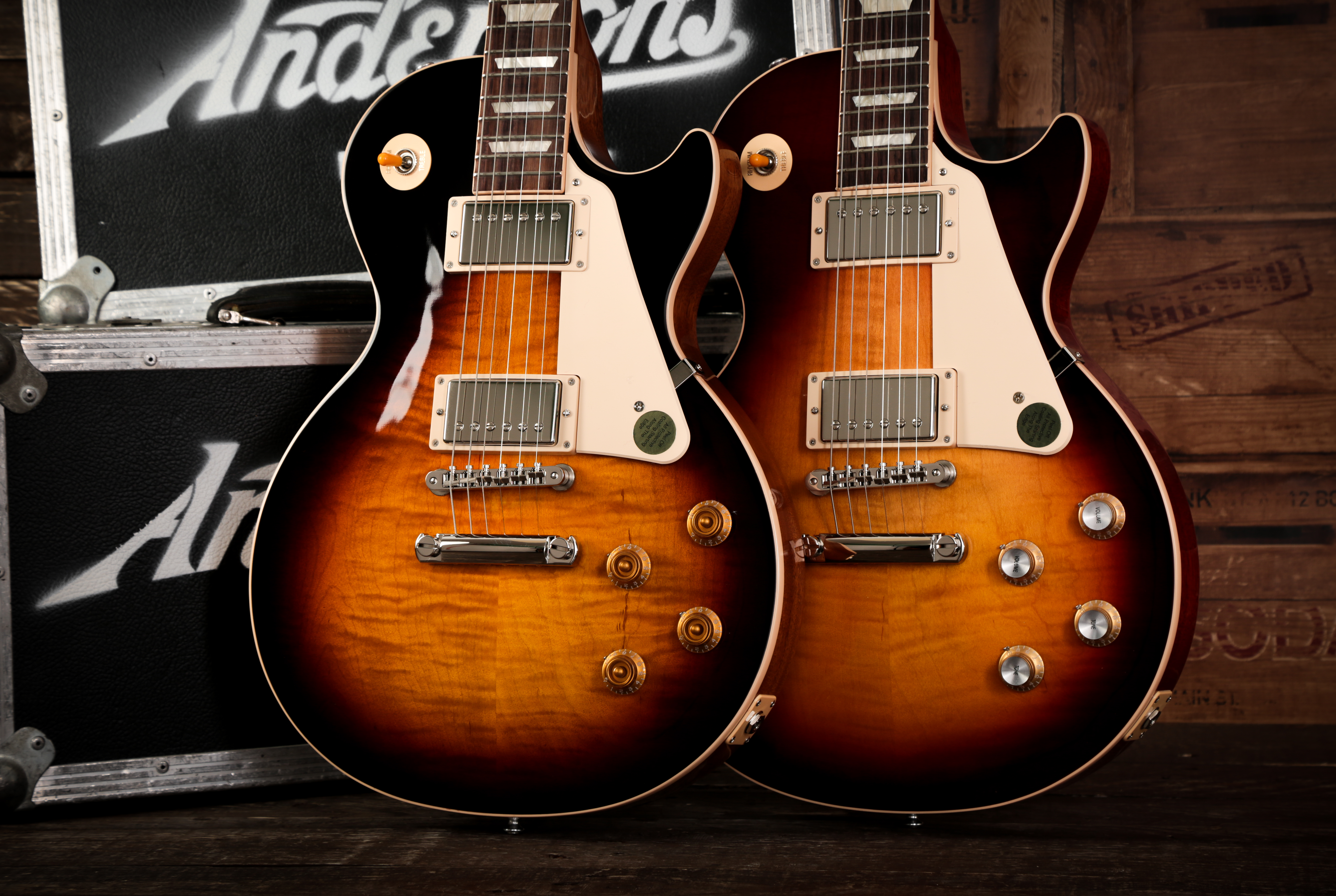’50s vs ’60s Les Paul Guitars: The Key Differences
Both the ‘50s and ‘60s Les Paul guitars share that quintessential Les Paul DNA. But take a look under the hood (or even at the hood itself!) and you’ll find a few telling differences that really set them apart.
In this section, we’ll take a closer look at the biggest differences between the two models, but if you’re looking for a quick summary of the key points, here’s what you need to know:
- Neck Shape: ’50s models have thicker, rounder necks; ’60s models use the slim taper profile.
- Pickups: ’50s guitars typically feature either warmer PAF-style or P-90 single coil pickups; ’60s Les Pauls have humbuckers with the more aggressive Alnico V magnets.
- Styling: ’50s Les Pauls lean heavily into a classy vintage look, whereas the ’60s models tend to be flashier, often with vibrant flame tops.
- Hardware: ’60s models feature Grover tuners; ’50s models use Kluson machine heads.
- Feel: ’50s LPs are notably heavier with chunkier necks, giving them a more traditional vintage feel. On the other hand, ‘60s LPs are made to better suit the more intricate and agile playing style of later years.
’50s Les Paul Pickups vs ’60s Les Paul Pickups
As we discussed earlier, there’s some pretty noticeable differences between the sound of the ‘50s and ‘60s LPs, and a big part of that is down to the choice of pickups. Early ’50s Les Pauls were outfitted with P-90 single-coils – gritty, raw, and harmonically rich. By the late ’50s, Gibson introduced the now legendary PAF humbuckers. They had a lower output, but they more than made up for that with tonnes of extra clarity and note separation.
In contrast, ’60s models came out swinging with hotter pickups, courtesy of the new Alnico V magnets. These offered more midrange bite, increased sustain, and sharper articulation, making them a superb choice for rock lead work, cutting through mixes with ease. In today’s ‘60s Standards, you’ll find Burstbucker 61R and 61T pickups, which are voiced for a blend of vintage heat and modern clarity.
’50s vs ’60s Les Paul Tonewoods
Both Les Paul eras featured the same classic mahogany body and neck with a maple cap. But look a little closer and there are a few differences:
- ’50s guitars generally had thicker maple tops with much more subtle figuring.
- ’60s models heavily leaned into highly figured flame maple, often AA grade or better.
- Both versions typically use rosewood fingerboards, although modern ’60s guitars sometimes use Indian Laurel on lower budget models.
- The neck tenon and joint may also differ slightly between reissues, which could make a small difference in sustain and resonance.
’50s vs ’60s Les Paul Guitars: Style Differences
The ’50s LP screams understated class; gold tops, subtle bursts, and vintage details that harken back to a golden age of guitar craftsmanship. Hardware finishes like aged nickel and vintage-style Kluson tuners only add to the retro charm, rounding off an overall look that’s warm, classic, and drenched in heritage.
In almost stark contrast, the ’60s Les Pauls turned up the heat when it comes to visual flair. These guitars rocked an altogether bolder look, with finishes like vibrant cherry sunbursts and rich tobacco bursts paired with AA flame maple tops that really catch the eye under stage lights. Grover tuners and silver reflector knobs completed the ’60s LPs’ much more modern look, dragging the Les Paul kicking and screaming into the next decade.
Playability of ’50s Les Pauls vs ’60s Les Pauls
Given what we’ve already discussed, it should come as no surprise that the biggest difference in playability comes down to neck shape. Essentially:
- ’50s Les Paul necks are chunky, offering a substantial grip and a more traditional feel that’s great for blues and rhythm players.
- ’60s Les Paul necks are far slimmer and faster, naturally making them more favoured by shredders and lead guitarists.
The rounded profiles of those ’50s necks are sometimes referred to as baseball bats – but for many a guitarist, that’s a good thing! They feel great if you’re a player who likes to dig in, their tactile, vintage feel enabling a strong vibrato and expressive bends.
Meanwhile, the slim taper necks on ’60s Les Pauls are much more accommodating for both smaller hands and high-speed lead runs. As such, they’re a better fit for players who ply their trade in modern play styles, whether that’s tapping, sweeping, or blazing up and down the neck.
Other factors, like weight relief and balance, can also have an impact on playability. With their thicker maple tops and chunkier necks, ’50s models are usually heavier, and some players believe this contributes to a more stable and resonant feel when playing standing up. But the zippier ’60s models, on the other hand, often feel a touch more agile and gig ready.
’50s vs ’60s Les Paul Guitars: Which is Better?
When we’re talking about two of the most innovative and cherished guitars in the history of the instrument, it’s probably not a shock to learn that there’s no clear-cut winner here! If you’re trying to decide between the two, think about things like the style of music you play, the size of your hands, and even what your preference is for how a guitar looks. It all depends on what you’re looking for out of your axe:
Want warmth, understated vintage looks, and a rock-solid neck? Go for the ’50s Les Paul.
Prefer a guitar that looks a little bolder, plays faster, and produces brighter tones? Think about picking up a ’60s Les Paul.
Les Paul Alternatives
If you love either the ’50s or ’60s Les Paul style but need something. A bit more modern and perhaps a tad more affordable, there’s some cracking alternatives out there you might want to consider:
- Epiphone Les Paul Standard ’50s/’60s: These Epiphone models capture the look and feel of classic Gibsons without the hefty price tag. With ProBucker pickups and classic neck profiles, they’re perfect for players searching for authentic tones on a budget.
- Gibson Les Paul Studio: Offering a stripped-down version of the Les Paul Standard, Gibson Studio guitars are weight-relieved for comfort and come with powerful pickups – perfect for gigging musicians who want premium tone with all the benefits of modern playability.
- PRS SE Series: A great single-cut alternative with a slightly shorter scale and wide-fat neck. The SE Series guitars deliver thick Les Paul-esque tones with excellent tuning stability and exceptional build quality at a competitive price point.
’50s vs ’60s Les Paul Guitars: FAQS
Are ’50s Les Pauls heavier than ’60s models?
Generally speaking, yes. ’50s models don’t have weight relief and have a chunkier neck, so they tend to be noticeably heavier.
Do ’50s Les Pauls have better tone than ’60s Les Pauls?
Tone is subjective! That said, ’50s LPs are typically warmer and more rounded, whereas ’60s LPs are brighter and more focused. If you gravitate towards one of those sounds, then that’s the Les Paul for you!
Which Les Paul is better for blues?
Many blues players prefer the ’50s models for their warmth, sustain, and classic looks.
Which Les Paul is better for rock?
The faster neck and hotter pickups of the ’60s Les Paul model make it a more popular choice for classic and hard rock.
Is the neck size really that different?
In a word? Yes! The ’50s “baseball bat” neck is considerably chunkier than the slim taper neck that you’ll find on the ’60s Les Paul. If your hands are on the small side, you might find it a bit of a stretch at first, although it’s not insurmountable with practice!
Do modern Gibson Les Paul Standards replicate the originals?
Modern reproductions do a surprisingly good job of matching the OG models, especially in the USA Standard range and historic reissues from the Gibson Custom Shop.
Want to Learn More?
Enjoyed reading this article? Check out more of our Learn and Industry articles!












Responses & Questions